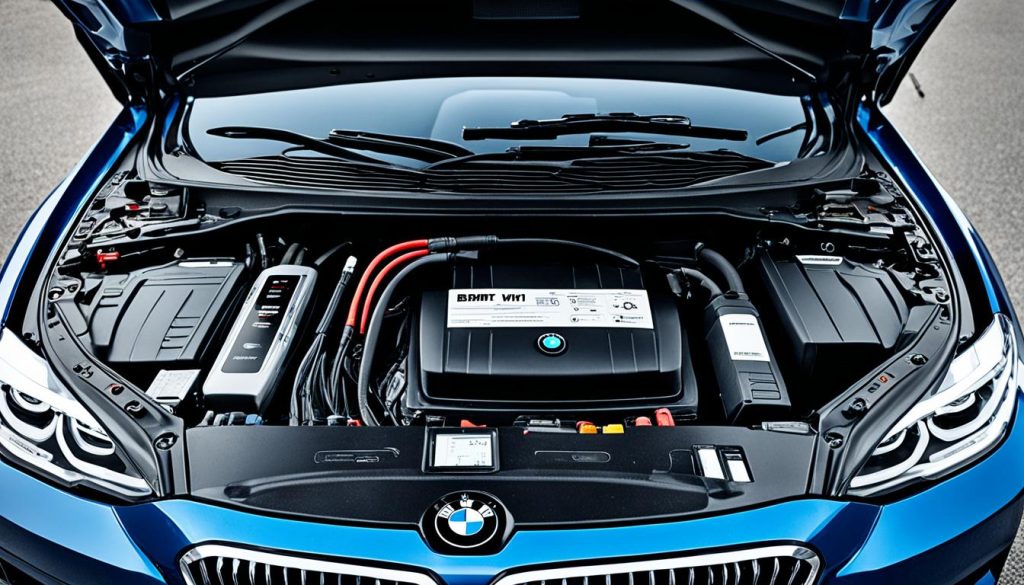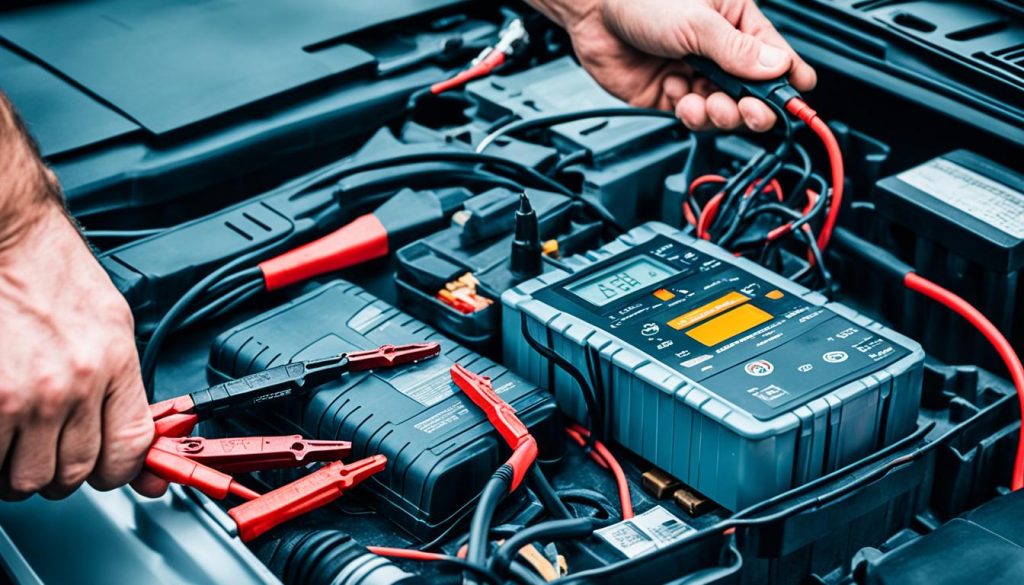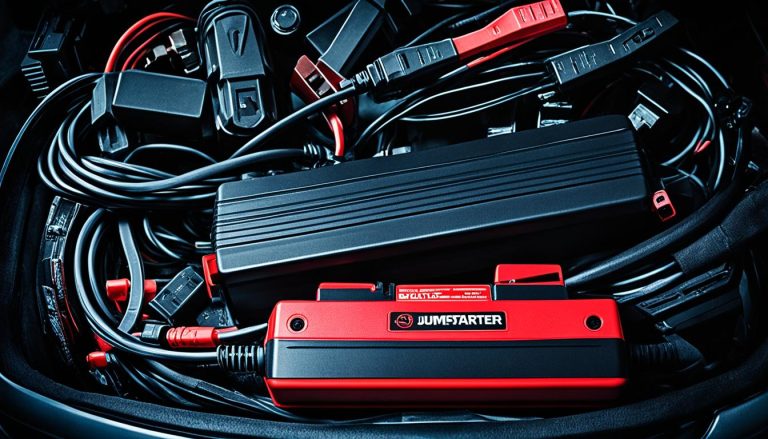Jump Start Your BMW: Battery in Trunk Guide
batterychargers.site and its partners may earn a commission if you purchase a product through one of our links
If you’re the proud owner of a BMW, you know the exhilaration of driving a vehicle that merges luxury with performance. However, even the most sophisticated cars have their moments, and a dead battery can leave anyone feeling stranded. But don’t worry, knowing how to jump start a BMW with the battery in the trunk is easier than you might think, and you’ll be back on the road in no time. Whether you find your vehicle reluctant to wake up in your garage or a parking lot, the following jump start BMW with battery in trunk procedure will help you safely get your BMW’s heart beating again.
Typically, your BMW’s battery is nestled in the trunk to optimize weight distribution and handling, which might seem challenging at first, but the well-thought-out German engineering provides accessible jump start terminals under the hood. By following the right steps and precautions, you’ll safely jump start a BMW with a trunk-mounted battery, sidestepping any possible electrical mishaps. So, let’s make sure that your drive never skips a beat!
Key Takeaways
- Always locate your BMW’s dedicated jump start terminals under the hood instead of connecting directly to the battery in the trunk.
- Utilize the metal blade from your key fob to gain manual access to your BMW if the battery is dead.
- Ensure good contact between cables and jump box to successfully start the engine after jump-starting.
- If your BMW won’t start after jump-starting, the issue may lie beyond the battery and require further troubleshooting.
- For safety, turn off all electrical accessories before and during the jump start procedure.
- Keep jumper cables connected for 15 minutes if needed, to allow adequate charge transfer before attempting to start your BMW.
Understanding the BMW Trunk Battery Configuration
If you’re driving a BMW, there’s a good chance that your vehicle’s battery is located in the trunk. This might seem unconventional, but it actually serves an important purpose in terms of weight distribution and overall performance. Now, should you find yourself with a dead battery, it’s essential to know the proper steps for starting a BMW with a battery in trunk to prevent any unwanted damage to the vehicle’s sophisticated electrical system.
When the time comes for BMW dead battery troubleshooting, you won’t be connecting jumper cables straight to the battery. Instead, BMWs are equipped with designated BMW engine bay jump terminals. These terminals are strategically placed within the engine bay to facilitate the safe transfer of power from a donor battery or jump pack.
- Locate the positive jump terminal, typically covered by a red cap and marked with a plus sign.
- Connect the positive jumper cable to this terminal.
- Find a solid, non-painted metal surface on the car’s frame to serve as a grounding point.
- Attach the negative jumper cable to your grounding point.
If your BMW’s battery is completely discharged, it may be necessary to keep the jumper cables connected for approximately 15 minutes, allowing enough energy transfer to start the engine. Symptoms of a dead battery include dimming headlights, slow crank, or several dashboard warnings—all signs that should prompt immediate action.
When dealing with a dead BMW battery, the follow-up actions you take are as important as the initial jump-start. Therefore, here’s a simple table to guide you through the fundamentals:
| Symptom | Potential Cause | Suggested Action |
|---|---|---|
| Dim lights | Battery losing charge | Check battery terminals for corrosion; consider battery replacement if old or damaged |
| Slow cranking engine | Insufficient battery power | Ensure a solid connection of jumper cables; check for alternator issues |
| Dashboard warnings | Various electrical faults | Use a diagnostic scanner post-jump to pinpoint exact issues |
| No start with push-button | Fully discharged battery | Extend connection time with jumper cables for better power transfer |
Remember, mitigating the risks associated with a dead battery starts with recognizing the unique setup of your BMW—and with this newfound knowledge, you’re better equipped to handle the situation with confidence.
Pre-Jump Start Checklist for Your BMW
Ensuring that you are ready to perform a jump start on your BMW with a trunk-mounted battery is paramount. Below, you’ll find a checklist that includes locating jump start terminals, gathering essential tools, and implementing safety measures. This will help you execute the jump start procedure for your BMW with confidence and care.
Locating Your BMW’s Jump Start Terminals
Before starting the process, you need to identify where the jump start terminals are situated within the engine bay of your BMW. Typically shielded with a plastic cover displaying a positive (+) sign, these terminals are your lifeline to resurrecting your vehicle’s drained battery. Remember, jumping directly from the battery is not advised, as it’s located in the trunk and connecting there could lead to potential safety risks.
Essential Tools for Jump Starting a BMW with a Trunk Battery
You will require a few important tools to jump start a BMW with a trunk-mounted battery safely. A 12V jump starter or another vehicle with a fully charged battery is essential. Additionally, ensure that you have a pair of quality jumper cables which will facilitate the BMW jump start cable connection seamlessly.

Safety Measures Before Jump Starting Your BMW
Your safety is the top priority when preparing to jump start your BMW. Switch off all electrical accessories and stand clear of the battery during the process. Make sure to secure the red jumper cable to the positive terminal and affix the black cable to a grounding point on the chassis. Following these jump start a BMW with trunk-mounted battery steps carefully will ensure a safe and successful jump start.
How to jump start a bmw with battery in trunk
If you find yourself with a BMW that won’t start due to a dead battery located in the trunk, jump-starting it is a process you can undertake with confidence by following the right steps. Safety is paramount when performing this procedure, so take care to connect cables correctly and avoid any possible electrical hazards.
Step-by-Step Guide to Jump Start Cable Connection
Getting your BMW’s engine to turn over with a jump start involves a few precise steps:
- Position the jump start device or the assisting vehicle close to the front of your BMW.
- Locate the positive terminal in your BMW’s engine bay, typically capped with a red plastic cover.
- Take the red (positive) jumper cable and connect it securely to the positive jump start terminal of your BMW.
- Find a solid, unpainted metal surface on your BMW’s frame or engine block to serve as a grounding point.
- Connect the black (negative) jumper cable to your chosen grounding point.
- Ensure that both connections are secure and that the cables do not interfere with any moving parts.

These steps form the fundamental process for safe and effective jump-starting of your vehicle.
Troubleshooting Tips When Jump Starting a BMW
Occasionally, you may encounter issues while jump-starting your BMW. Here are some troubleshooting tips:
- If the car doesn’t start, check to ensure the jump starter is fully charged.
- Verify that the jumper cable clamps have a clean and strong connection to both terminals and the grounding point.
- If you hear nothing but a clicking sound, leave the jump starter connected a little longer to help transfer more power to the battery.
- In some cases, your BMW may require several attempts to start. Patience is key here.
Remember, successful troubleshooting often involves checking and rechecking the basics.
Starting the Engine After Successful Jump Connection
Once the cables are connected and you’ve addressed any initial issues:
- Start the vehicle providing the charge, letting it run for a few minutes to build up charge.
- Turn your BMW’s ignition to the start position and hold it until the engine turns over.
- Once your BMW starts, let it idle for several minutes to ensure the battery receives enough charge to keep the vehicle running.
- Finally, carefully disconnect the jumper cables, starting with the negative (black) cable, followed by the positive (red) cable.
These steps will help you successfully start your BMW after a proper jump connection is established.
Being able to jump start your BMW with the battery in the trunk is a useful skill that can save you from emergency roadside situations. Remember to always handle jumper cables with care, and if you’re unsure about any step of the process, don’t hesitate to seek professional assistance.
Charging a Dead BMW Battery vs Jump Starting
When faced with a dead BMW battery, many may consider jump-starting as the go-to solution for a quick fix. However, if you’re dealing with a truly depleted battery, charging a dead BMW battery might be a more appropriate approach for your BMW battery maintenance plan. Using a smart battery charger introduces charge at a controlled rate, known as trickle charging, benefiting your battery’s longevity and preserving your vehicle’s electrical system integrity.
On the other hand, a battery jump start guide for BMW with trunk-mounted battery is invaluable for those urgent situations where immediate power is needed. Though effective in the short term, jump starting does not provide your battery the gradual recharge it may need to restore its full capacity, potentially leading to recurring issues.
Here’s a closer look at both methods to help you decide the best course of action:
| Criteria | Trickle Charging | Jump Starting |
|---|---|---|
| Process | Slow, steady electrical current over several hours | Immediate charge for starting the engine |
| Benefits | Gentle on battery; can recondition battery cells | Quick fix to get your BMW running |
| Risks | Takes time; may not be convenient in emergencies | Potential damage to the electrical system from power surges |
| When To Use | When the battery is drained from infrequent use or electrical drains | In time-sensitive situations where you need immediate use of your vehicle |
| Maintenance | Regular charging supports battery health | Good for irregular use, but not recommended as a regular fix |
If your BMW’s battery health is a concern, regularly performing battery maintenance is key to prolonging its life. Address any underlying causes for a dead battery, like corroded connections or electrical drains, before they escalate. Remember,
an ounce of prevention is worth a pound of cure.
Ultimately, choosing between trickle charging and jump starting depends on your situation and needs. Both methods have their place in your automotive care toolkit, and understanding when to use each can keep your BMW in optimal condition.

Common Issues When Jump Starting a BMW with Trunk Battery
If you’ve attempted to jump start your BMW only to find it stubbornly refusing to come to life, you’re likely facing one of several common issues. Despite connecting the jump starter correctly, your BMW might still exhibit refusal to start, which can range from simple fixes to more complex electrical system issues. Understanding these problems can save you time and eliminate the frustration you might encounter.

**BMW Battery Troubleshooting** begins with identifying the signs that indicate a deeper problem. When your BMW won’t start after a jump, it may not always be due to a flat battery. Instead, the culprit could be the starter, the alternator, or even a more elusive electrical system issue. Here’s a clearer look into what might be going on:
- Completely discharged battery: Sometimes, if a battery is significantly drained, a standard jump-start might not immediately solve the problem. The battery may require extended jumper cable connection time to accumulate enough charge to start the engine.
- Alternator failure: If the alternator isn’t properly charging the battery while the engine runs, your BMW will repeatedly fail to start. A telltale sign of alternator trouble is a battery warning light on the dashboard after a jump-start attempt.
- Bad starter motor: A defective starter can mimic a dead battery’s symptoms. A common indication of a failing starter is a clicking sound when you turn the key, yet the engine does not crank.
Furthermore, **BMW electrical system issues** can complicate the situation beyond just battery concerns. A full system scan is recommended to diagnose these problems accurately. Now, let’s consolidate the troubleshooting by taking a birds-eye view of how to systematically deal with BMW jump start problems:
| Issue | Symptoms | Recommended Action |
|---|---|---|
| Dead Battery | Dim lights, slow crank | Extended connection, possible replacement |
| Alternator Failure | Battery warning light, poor accessory performance | Electrical system scan, repair or replace alternator |
| Bad Starter | Clicking sound, engine won’t crank | Inspect starter circuit, replace starter if necessary |
| Electrical System Issue | Various unusual electrical symptoms | Full system diagnostic, consult with a mechanic |
Keep in mind that if you continue facing difficulties and your BMW stubbornly remains non-responsive, professional assistance may be necessary. You should consider bringing your vehicle to a mechanic who can provide a thorough inspection and repair any underlying issues effectively.
Alternative Methods to Access a BMW Trunk with a Dead Battery
If you find yourself facing a dead battery in your BMW, gaining access to the trunk can be daunting. However, you don’t need to worry, as there are reliable methods to enter your trunk even when the battery won’t respond. We’ll explore the efficient unlocking techniques that you can use when faced with a BMW’s uncooperative battery, ensuring you’re equipped to tackle such challenges.
Unlocking Techniques for a BMW When the Battery is Unresponsive
The smart design of your BMW’s key fob is your first ally in this situation. Deploy the hidden physical key concealed within the fob to manually unlock the driver’s door. Once inside, you might have the option to fold down the back seats and create a pathway to the trunk. Some models also feature a BMW manual key slot, positioned discreetly on the trunk area or beneath the trim, for direct trunk access. Using these BMW trunk unlocking methods can save you time and alleviate the stress associated with a dead battery.
How to Charge Your BMW Battery without Opening the Trunk
When you need to revive your BMW’s battery but can’t reach it due to a locked trunk, there’s a practical solution. By connecting a trickle charger to the jump start terminals located in your car’s engine bay, you can slowly and safely recharge the battery. This approach can be incredibly helpful, especially if you’re wondering how to get into the trunk if the BMW battery is dead and conventional methods aren’t available or feasible. Remember, if all else fails and you remain locked out, it’s prudent to seek the assistance of roadside services for professional help.
FAQ
How do I jump start my BMW if the battery is in the trunk?
To jump start your BMW, locate the jump start terminals in the engine bay. Connect the red jumper cable to the positive terminal and the black cable to a grounding point on the vehicle. Start the engine of the donor vehicle or switch on the jump box, then start your BMW.
Where are the jump start terminals located in my BMW?
The jump start terminals in your BMW are typically found in the engine bay. Look for a red plastic cover marked with a positive (+) sign for the positive terminal, and use a solid metal point on the frame or engine block as a ground.
What tools do I need to jump start my BMW with a trunk battery?
You’ll need a set of jumper cables and a jump box or another vehicle with a working battery. Ensure the donor battery is 12V and in good condition to avoid complications.
What safety measures should I take before jump starting my BMW?
Turn off all electrical accessories, and ensure that your BMW and the donor vehicle are turned off before connecting the jumper cables. Always attach the positive cable first, followed by the negative one. Keep in mind that the cables should not touch while the other ends are connected to a battery or power source.
What should I check if my BMW doesn’t start after attempting to jump start?
Check that the jumper cables have a solid connection to the terminals, that the donor battery or jump box is fully charged, and that all the lights and accessories are turned off in your BMW. If the car still doesn’t start, wait 15 minutes and try again, or consider trickle charging your battery. If problems persist, a professional diagnosis may be needed.
Is trickle charging better than jump starting a dead BMW battery?
Trickle charging can be more effective and less stressful on the battery than jump starting because it slowly builds up the charge. However, jump starting is quicker if done safely and correctly.
What are common issues I might face when jump starting my BMW?
Common issues include a battery that won’t hold a charge, a faulty alternator, a bad starter, or fuel delivery problems. Check for dim headlights or dashboard battery warnings to identify if it’s indeed a battery-related issue.
What are some ways to unlock my BMW’s trunk if the battery is completely dead?
Use the hidden physical key inside your BMW’s key fob to manually unlock the driver’s door. Some models have a manual key slot either on the trunk or below the tailgate trim. If you cannot access the trunk directly, you may fold the rear seats down from inside the cabin to reach the trunk.
How can I charge my BMW’s battery without opening the trunk?
Connect a trickle charger to the jump start terminals in your BMW’s engine bay. This method allows you to slowly charge the battery without accessing it directly.






